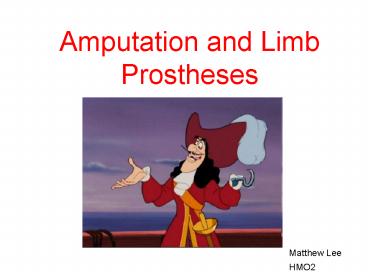Amputation and Prosthesis - PowerPoint PPT Presentation
1 / 15
Title:
Amputation and Prosthesis
Description:
Amputation and Limb Prostheses Matthew Lee HMO2 Learning Issues Background Definitions Anatomy Mechanisms of trauma Assessment of a mangled limb Treatment options and ... – PowerPoint PPT presentation
Number of Views:444
Avg rating:3.0/5.0
Title: Amputation and Prosthesis
1
Amputation and Limb Prostheses
Matthew Lee HMO2
2
Learning Issues
- Background
- Definitions
- Anatomy
- Mechanisms of trauma
- Assessment of a mangled limb
- Treatment options and indications for amputation
- Limb prostheses
3
Background
- Limb amputation is an uncommon and complex problem
- 90 of amputations are to the lower limb
- Massive trauma is the second leading cause of
amputation
- Traumatic amputation affects young adults
- Amputation leads to significantly lower physical
and social functioning
4
Definitions
- Amputation removal of a body extremity by
surgery or trauma
- Prosthesis artificial extension that replaces a
missing body part
5
Anatomy
6
Mechanisms of trauma
7
Assessment of the mangled limb
- Mechanism (explosion ? penetrating low energy)
- Patients condition (clinical, laboratory)
- Fracture characteristics
- Gustilo Classification for open tibial
- Soft tissue injury
- Vascular injury
8
Indications for amputation
- Lack of published evidence
- RMH trauma guidelines (level IV and consensus)
- Damage control surgery (clinical and laboratory
parameters) - Complete disruption of tibial nerve
- Massive crush injury (ischaemia gt6hours)
- Near complete traumatic amputation with
devascularisation or loss of muscle in all 4
crural compartments - Massive contamination
- Associated mangled ipsilateral foot
9
(No Transcript)
10
Treatment options
- Primary amputation (within 24 hours of injury)
- Early secondary amputation (within 5/7 of injury)
- Delayed secondary amputation (after first
hospitalisation) - Limb salvage
11
Limb prostheses
- Candidate selection
- Prosthesis selection
- Common problems
12
Candidate selection
- Projected function
- K level (0-3)
- Amputation level and stump contour
- Residual strength
- Prosthesis selection
- General health
- Medical comorbidities
- Cognition
- Vision
- Sensorimotor deficits
13
Prosthesis selection
- Basic considerations
- Comfort
- Ease of use
- Weight/durability
- Mechanics
- Cosmetics
- Types
- Preparatory
- Definitive
- Function
14
Common problems
- Pressure areas
- Contractures
- Phantom sensation, phantom pain
- Choke syndrome
- Dermatological problems
15
Thank you





![[READ]✔️ Living with a Below-Knee Amputation: A Unique Insight from a PowerPoint PPT Presentation](https://s3.amazonaws.com/images.powershow.com/10127380.th0.jpg?_=202409100211)

























